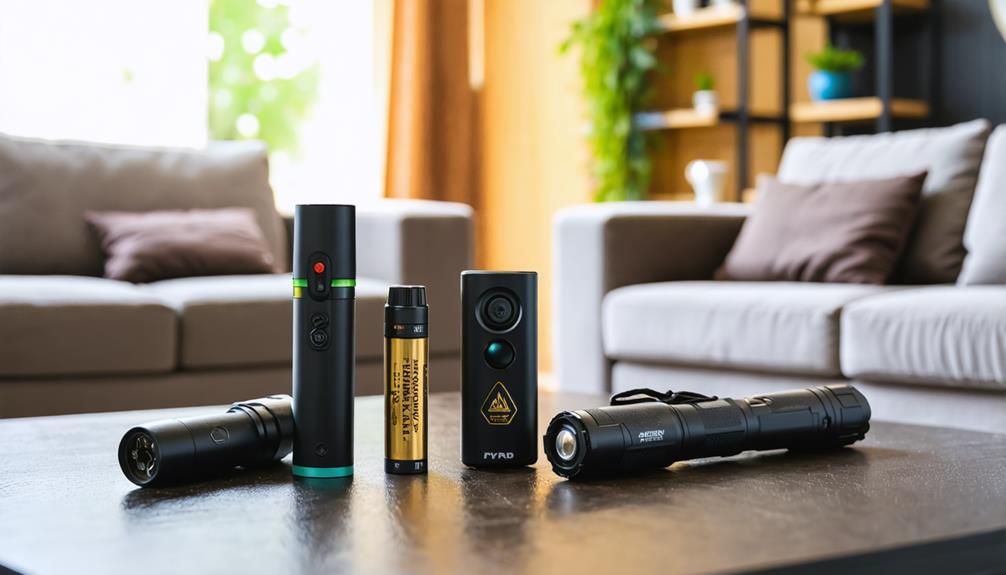
Brainstorm Security Shop

For Orders Over $199

On Any Of Our Products

Details On Refund Page

When it comes to home defense, you might be considering non-lethal options as a way to enhance your protection without escalating to deadly force. Tools like pepper spray, stun guns, and personal alarms can provide immediate deterrence against intruders, but understanding Non Lethal Home Defense Weapons and their effectiveness and legal implications is essential. You’ll want to know not just how these tools work, but also how to use them responsibly and effectively. What factors should you take into account when choosing the right non-lethal weapon for your home?
When it comes to home defense, understanding non-lethal options can be crucial for ensuring safety without causing unnecessary harm. You’re likely seeking effective ways to enhance your home security while minimizing the risk of serious injury to intruders or yourself. Non-lethal force offers a practical solution, allowing you to protect your space while adhering to legal and ethical considerations.
Consider how non-lethal options can fit into your overall home defense strategy. These tools can deter threats without escalating violence.
For instance, using pepper spray or a stun gun can incapacitate an intruder momentarily, giving you time to call for help or escape. Additionally, you might explore other non-lethal methods like alarm systems that alert you and your neighbors, or even security cameras that provide valuable evidence if needed.
When it comes to popular non-lethal weapons, pepper spray and personal alarm devices stand out. These tools are effective for deterring threats without causing permanent harm.
Let’s explore how they can enhance your home defense strategy.
For those seeking effective yet non-lethal home defense options, pepper spray stands out as a popular choice. Its portability and ease of use make it an attractive alternative to more aggressive self-defense tools. However, it’s essential to understand both the benefits and limitations of pepper spray to use it effectively in emergencies.
| Aspect | Details |
|---|---|
| Benefits | Immediate incapacitation of an attacker |
| Easy to carry and conceal | |
| Non-lethal, reducing legal repercussions | |
| Limitations | Wind can affect direction and potency |
| May not work on individuals with certain conditions | |
| Requires close proximity to the threat |
While pepper spray is effective for many, you might also consider alternatives like stun guns or personal alarms. Each option comes with its own effectiveness and situational advantages. Ultimately, knowing your environment and assessing your comfort level with these tools will help you choose the best non-lethal option for your home defense needs.
Personal alarm devices serve as an effective non-lethal home defense option, combining simplicity with powerful deterrence. These compact safety alarms emit a loud sound—often reaching 120 decibels—when activated, making them an excellent tool for personal protection. The disruptive noise can startle an intruder, drawing attention and potentially scaring them away.
Using a personal alarm is straightforward. You can carry one on your keychain or keep it within easy reach at home. In a threatening situation, just pull the pin or press the button to activate the alarm. This immediate response can’t only alert you but also signal to others nearby that you need help.
These devices are particularly useful for individuals who may not feel comfortable with more aggressive forms of self-defense. They’re also a great option for children or elderly family members who may need extra security.
When paired with other safety measures, personal alarms enhance your overall home defense strategy.
In a world where safety is paramount, investing in a personal alarm device could be a smart choice for ensuring your peace of mind.
Many people find non-lethal home defense tools to be a practical option for deterring intruders while minimizing the risk of severe injury. These tools can provide a non-lethal impact, allowing you to protect yourself and your loved ones without resorting to deadly force. When considering the effectiveness of various non-lethal options, it’s essential to look at how they compare.
Here’s a quick effectiveness comparison of common non-lethal home defense tools:
| Tool | Range | Non-Lethal Impact |
|---|---|---|
| Pepper Spray | Up to 10 ft | Causes temporary blindness and respiratory distress |
| Stun Gun | Up to 15 ft | Disrupts muscle function, incapacitating for a short time |
| Personal Alarm | Varies | Creates a loud noise to attract attention and scare off intruders |
| Rubber Bullet | 100+ ft | Causes pain and potential bruising, but non-lethal |
| Bean Bag Round | 50+ ft | Stuns and disorients without penetrating the skin |
When considering non-lethal home defense tools, it’s important to understand the legal implications of using such devices. The use of force in self-defense situations can be a complex legal area, and knowing your rights and responsibilities is crucial. Different states have varying self-defense laws, which can influence how and when you can use these tools.
In general, self-defense laws allow you to protect yourself and your property, but the level of force you can use must be proportional to the threat. Non-lethal weapons like pepper spray or stun guns may be seen as reasonable options in many jurisdictions, but their legality can depend on local laws. For instance, some areas may restrict or regulate specific devices, so it’s wise to research your state’s regulations.
Additionally, if you ever have to use one of these tools, be prepared to justify your actions. Document any threats or incidents leading up to the situation, and ensure you can demonstrate that your response was appropriate under the circumstances. Understanding these considerations will help you make informed decisions about your home defense strategy while staying within legal boundaries.
Although you may feel secure in your home, implementing best practices for home defense is essential to enhance your safety. Start by assessing your home security. Check all doors and windows to ensure they’re locked and secure. Installing deadbolts and reinforcing entry points can deter potential intruders.
Next, consider investing in non-lethal home defense weapons, like pepper spray or a stun gun. These tools can provide effective self-protection without causing permanent harm. Keep them accessible, but out of reach of children.
Lighting plays a crucial role in home defense, too. Install motion-sensor lights around your property to illuminate dark areas and deter unwanted visitors. Inside your home, use timers on lights to create the illusion that you’re present, even when you’re not.
Establish a communication plan with your family. Discuss what to do in case of an emergency and practice escape routes.
When it comes to non-lethal home defense, practice is essential for building your confidence and skills. Engaging in scenario-based training helps you prepare for real-life situations, ensuring you know how to react when it counts.
Always prioritize safety protocols to protect yourself and your loved ones during your training sessions.
Practicing with your non-lethal home defense weapons isn’t just a good idea—it’s essential for ensuring your safety and confidence in a high-pressure situation. Regular practice allows you to develop the skills necessary to effectively use these tools when it counts. Whether you’re using pepper spray, a stun gun, or a personal alarm, familiarity with your weapon enhances your response time and reduces the likelihood of panic.
Skill development is crucial. As you train, you’ll learn the nuances of each weapon, including how it operates and the best ways to deploy it. This hands-on experience not only builds muscle memory but also boosts your confidence, helping you to react calmly and decisively in stressful moments.
Make it a habit to practice regularly. Set aside time each week to work on your techniques, simulate scenarios, and improve your aim and accuracy. Incorporate different environments, so you can adapt your skills to various situations you may face at home. By committing to this practice, you ensure that when the time comes to defend yourself, you’ll be prepared and capable of handling the situation effectively.
Engaging in scenario-based training can significantly enhance your preparedness for real-life situations. When you immerse yourself in realistic simulations, it helps you develop the skills and reactions you need in a crisis. These hands-on practice sessions allow you to better understand how to respond under pressure.
Consider incorporating the following elements into your training:
Establishing safety protocols is crucial for effective home defense. It’s essential to prioritize safety precautions to ensure that you and your loved ones remain protected while using non-lethal home defense weapons. Start by familiarizing yourself with the specific weapon you choose. Proper handling is key; practice how to operate it safely under various scenarios.
Regular training sessions will help reinforce your understanding of safety protocols. Consider enrolling in a class focused on non-lethal defense tactics. These classes often cover critical aspects such as target identification, de-escalation techniques, and legal considerations surrounding the use of non-lethal weapons.
Create a safety plan that includes escape routes and designated safe areas within your home. Ensure everyone in your household understands this plan and knows how to respond in emergencies. Practice drills regularly to build confidence and familiarity with your safety protocols.
When considering the average cost, you’ll find prices range widely. Conduct a cost comparison to see monthly expenses versus effectiveness evaluation for your needs. This helps you invest wisely in the best options available.
Yes, you can use non-lethal alternatives for outdoor self-defense. They provide effective protection without causing permanent harm. Always check local laws to ensure you’re using them responsibly and legally in different situations.
To store your weapons safely at home, ensure proper storage in a secure, locked cabinet. Implement safety measures, like keeping them out of reach of children, and regularly check for any damage or malfunctions.
Yes, there are age restrictions for purchasing self-defense tools. You’ll need to check local laws, as legality concerns vary by state. Typically, buyers must be at least 18, but some items might have different requirements.
You should inspect your equipment regularly. The recommended maintenance frequency is at least once a month. This ensures everything functions properly and stays reliable when you need it most. Don’t overlook those routine checks!
Brainstorm Security Shop
1867 Caravan Trail
Ste 105
Jacksonville, FL 32216
Call us toll free: (800) 859-5566